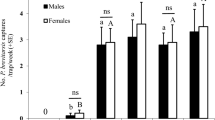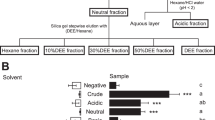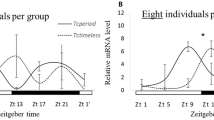Abstract
Locust plagues threaten agricultural and environmental safety throughout the world1,2. Aggregation pheromones have a crucial role in the transition of locusts from a solitary form to the devastating gregarious form and the formation of large-scale swarms3,4. However, none of the candidate compounds reported5,6,7 meet all the criteria for a locust aggregation pheromone. Here, using behavioural assays, electrophysiological recording, olfactory receptor characterization and field experiments, we demonstrate that 4-vinylanisole (4VA) (also known as 4-methoxystyrene) is an aggregation pheromone of the migratory locust (Locusta migratoria). Both gregarious and solitary locusts are strongly attracted to 4VA, regardless of age and sex. Although it is emitted specifically by gregarious locusts, 4VA production can be triggered by aggregation of four to five solitary locusts. It elicits responses specifically from basiconic sensilla on locust antennae. We also identified OR35 as a specific olfactory receptor of 4VA. Knockout of OR35 using CRISPR–Cas9 markedly reduced the electrophysiological responses of the antennae and impaired 4VA behavioural attractiveness. Finally, field trapping experiments verified the attractiveness of 4VA to experimental and wild populations. These findings identify a locust aggregation pheromone and provide insights for the development of novel control strategies for locusts.
This is a preview of subscription content, access via your institution
Access options
Access Nature and 54 other Nature Portfolio journals
Get Nature+, our best-value online-access subscription
$29.99 / 30 days
cancel any time
Subscribe to this journal
Receive 51 print issues and online access
$199.00 per year
only $3.90 per issue
Buy this article
- Purchase on Springer Link
- Instant access to full article PDF
Prices may be subject to local taxes which are calculated during checkout




Similar content being viewed by others
Data availability
Sequence data of Or35 that supporting the findings of this study have been deposited in GenBank with the accession code KP843355. All data supporting the findings of this study are available within the Article, the Extended Data and the Supplementary Information files. Source data are provided with this paper.
References
Uvarov, B. P. Grasshoppers and Locusts: A Handbook of General Acridology. Vol. I: Anatomy, Physiology, Development, Phase Polymorphism, Introduction to Taxonomy (Cambridge Univ. Press, 1966).
Zhang, L., Lecoq, M., Latchininsky, A. & Hunter, D. Locust and grasshopper management. Annu. Rev. Entomol. 64, 15–34 (2019).
Pener, M. P. & Simpson, S. J. Locust phase polyphenism: an update. Adv. Insect Physiol. 36, 1–272 (2009).
Wang, X. & Kang, L. Molecular mechanisms of phase change in locusts. Annu. Rev. Entomol. 59, 225–244 (2014).
Nolte, D. J., Eggers, S. H. & May, I. R. Locust pheromone—locustol. J. Insect Physiol. 19, 1547–1554 (1973).
Fuzeau-Braesch, S., Genin, E., Jullien, R., Knowles, E. & Papin, C. Composition and role of volatile substances in atmosphere surrounding two gregarious locusts, Locusta migratoria and Schistocerca gregaria. J. Chem. Ecol. 14, 1023–1033 (1988).
Niassy, A. et al. Intra- and interspecific aggregation responses of Locusta migratoria migratorioides and Schistocerca gregaria and a comparison of their pheromone emissions. J. Chem. Ecol. 25, 1029–1042 (1999).
Wei, J. et al. Composition and emission dynamics of migratory locust volatiles in response to changes in developmental stages and population density. Insect Sci. 24, 60–72 (2017).
Wei, J. et al. Phenylacetonitrile in locusts facilitates an antipredator defense by acting as an olfactory aposematic signal and cyanide precursor. Sci. Adv. 5, eaav5495 (2019).
Wang, Z. et al. Identification and functional analysis of olfactory receptor family reveal unusual characteristics of the olfactory system in the migratory locust. Cell. Mol. Life Sci. 72, 4429–4443 (2015).
Wang, X. et al. The locust genome provides insight into swarm formation and long-distance flight. Nat. Commun. 5, 2957 (2014).
Li, Y. et al. CRISPR/Cas9 in locusts: Successful establishment of an olfactory deficiency line by targeting the mutagenesis of an odorant receptor co-receptor (Orco). Insect Biochem. Mol. Biol. 79, 27–35 (2016).
Hassanali, A., Njagi, P. G. & Bashir, M. O. Chemical ecology of locusts and related acridids. Annu. Rev. Entomol. 50, 223–245 (2005).
Wang, Q. B. et al. Chemical variation in the essential oil of Ephedra sinica from Northeastern China. Food Chem. 98, 52–58 (2006).
Milet-Pinheiro, P., Goncalves, E. G., Navarro, D. M. D. F., Nunez-Avellaneda, L. A. & Maia, A. C. D. Floral scent chemistry and pollination in the neotropical aroid genus Xanthosoma (Araceae). Flora 231, 1–10 (2017).
de Bruyne, M., Foster, K. & Carlson, J. R. Odor coding in the Drosophila antenna. Neuron 30, 537–552 (2001).
Hallem, E. A., Ho, M. G. & Carlson, J. R. The molecular basis of odor coding in the Drosophila antenna. Cell 117, 965–979 (2004).
Ochieng, S. A., Hallberg, E. & Hansson, B. S. Fine structure and distribution of antennal sensilla of the desert locust, Schistocerca gregaria (Orthoptera: Acrididae). Cell Tissue Res. 291, 525–536 (1998).
You, Y., Smith, D. P., Lv, M. & Zhang, L. A broadly tuned odorant receptor in neurons of trichoid sensilla in locust, Locusta migratoria. Insect Biochem. Mol. Biol. 79, 66–72 (2016).
Ma, C. et al. Mitochondrial genomes reveal the global phylogeography and dispersal routes of the migratory locust. Mol. Ecol. 21, 4344–4358 (2012).
Stige, L. C., Chan, K. S., Zhang, Z., Frank, D. & Stenseth, N. C. Thousand-year-long Chinese time series reveals climatic forcing of decadal locust dynamics. Proc. Natl Acad. Sci. USA 104, 16188–16193 (2007).
Wang, Y., Yang, P., Cui, F. & Kang, L. Altered immunity in crowded locust reduced fungal (Metarhizium anisopliae) pathogenesis. PLoS Pathog. 9, e1003102 (2013).
Tong, X., Wang, Y., Yang, P., Wang, C. & Kang, L. Tryptamine accumulation caused by deletion of MrMao-1 in Metarhizium genome significantly enhances insecticidal virulence. PLoS Genet. 16, e1008675 (2020).
Obeng-Ofori, D., Torto, B., Njagi, P. G., Hassanali, A. & Amiani, H. Fecal volatiles as part of the aggregation pheromone complex of the desert locust, Schistocerca gregaria (Forskal) (Orthoptera: Acrididae). J. Chem. Ecol. 20, 2077–2087 (1994).
Pregitzer, P. et al. In search for pheromone receptors: certain members of the odorant receptor family in the desert locust Schistocerca gregaria (Orthoptera: Acrididae) are co-expressed with SNMP1. Int. J. Biol. Sci. 13, 911–922 (2017).
Ignell, R., Anton, S. & Hansson, B. S. The antennal lobe of orthoptera—anatomy and evolution. Brain Behav. Evol. 57, 1–17 (2001).
Song, H. Phylogenetic perspectives on the evolution of locust phase polyphenism. J. Orthop. Res. 14, 235–245 (2005).
Kang, L. et al. The analysis of large-scale gene expression correlated to the phase changes of the migratory locust. Proc. Natl Acad. Sci. USA 101, 17611–17615 (2004).
Guo, X. et al. Dop1 enhances conspecific olfactory attraction by inhibiting miR-9a maturation in locusts. Nat. Commun. 9, 1193 (2018).
Acknowledgements
We thank C. Z. Wang for his technical assistance on olfactory receptor identification; X. H. Li for assistance on analysing the field data; J. Yang for assistance on graphic presentation using R platform; F. C. Tang for sharing Software Origin and SPSS. We thank North Dagang Waterland Reserve for field trapping experiments. This research is supported by the National Natural Science Foundation of China (grant nos. 31920103004, 31872303 and 31930012) and grants from Chinese Academy of Sciences (nos. 152111KYSB20180036, QYZDY-SSW-SMC009 and XDB11010200).
Author information
Authors and Affiliations
Contributions
L.K., X.G. and J.W. conceived and designed the experiments. X.G., Q.Y. and J.Y. performed behavioural assays in the laboratory. X.G., Q.Y., J.W. and J.Y. performed chemical collection and analysis. Q.Y. performed electroantennograms and single sensillum recordings. D.C. performed scanning of sensilla using electron microscopy, and electrophysiological recording in Xenopus oocyte system. X.G. performed immunohistochemistry of OR35 in locust antennae. X.G., Q.Y., D.C. and X.W. performed experiments on OR35 mutant locusts. X.G., Q.Y., J.W., J.Y. and X.W. performed experiments in artificial turf and fields. X.G., Q.Y., P. Y. and L.K. contributed to data analysis and interpretation. X.G., Q.Y., J.W. and L.K. wrote the manuscript.
Corresponding authors
Ethics declarations
Competing interests
The authors declare no competing interests.
Additional information
Peer review information Nature thanks Amir Ayali, Leslie B. Vosshall and the other, anonymous, reviewer(s) for their contribution to the peer review of this work. Peer reviewer reports are available.
Publisher’s note Springer Nature remains neutral with regard to jurisdictional claims in published maps and institutional affiliations.
Extended data figures and tables
Extended Data Fig. 1 4VA has strong attractiveness to the migratory locust.
a, The total movement distances of gregarious locusts in PAN, BA, 4VA, DP, PhA, and AS zone, compared with those in control zone. n = 30, 28, 34, 33, 32, and 34 locusts, respectively. b, c, The total duration and movement distances of gregarious locusts in GA, PN, VT, Mix 1, and Mix 2 zone, compared with those in control zone. n = 30, 39, 32, 35, and 30 locusts, respectively. d, The total movement distances of gregarious locusts at different stadiums in 4VA zone. n = 41, 22, 20, and 18 locusts, respectively. e, f, The duration and the total movement distances of gregarious locusts at 8 h, 24 h, 48 h and 72 h after ecdysis in 4VA zone, compared with those in control zone. n = 21, 37, 25 and 22 locusts, respectively. g, The total movement distances of gregarious locusts in 4VA zone with different concentrations. n = 32, 36, 35, 34, 30, and 36 locusts, respectively. h, The total movement distances of gregarious locusts across different sexes in 4VA zone. n = 16, 20, 23, and 20 locusts, respectively. i, The total movement distances of solitary locusts at different stadiums in 4VA zone. n = 30, 27, 28, and 44 locusts, respectively. j, k, The duration and the total movement distances of solitary locusts at 8 h, 24 h, 48 h, and 72 h after ecdysis in 4VA zone, compared with those in control zone. n = 11, 14, 17, and 15 locusts, respectively. l, The total movement distances of solitary locusts in 4VA zone with different concentrations. n = 31, 36, 34, 29, 32, and 35 locusts, respectively. m, The total movement distances of solitary locusts across different sexes in 4VA zone. n = 15, 20, 24, and 20 locusts, respectively. Behavioural data are presented as mean ± s.e.m. P values in behavioural assays were determined by Wilcoxon signed rank test.
Extended Data Fig. 2 The emission traits of 4VA in locusts.
a, The relative amounts of 4VA in the body and fecal volatiles of gregarious locusts, respectively. n = 5 biological replicates. b, 4VA emission amount in brain (Br), head integument (HI), tergum (Te), wing (Wi), foreleg and midleg (F&ML), hindleg (HL), abdominal integument (AI), thorax muscle (TM), fat body (FB), gastric caeca (GC) of gregarious locusts. n = 7 biological replicates. c, The 4VA fluctuation in gregarious locusts after ecdysis. n = 5 biological replicates. d, The emission amounts of 4VA in the solitary locusts after crowding for different durations. n = 5 biological replicates. Data are presented as mean ± s.e.m. Different letters indicate statistically significant differences between groups using one-way ANOVA (Tukey’s multiple comparisons test, P < 0.05) (b–d).
Extended Data Fig. 3 OR35 located in most basiconic sensilla.
a, Confocal microscopy images of OR35 location in locust antennae. ‘Bright’ indicated bright-field microscopy image. NC, negative control. b, In total 53 basiconic sensilla, 50 sensilla showed signals (Red arrow), and only 3 sensilla did not show signals (white arrow). These experiments in were performed three times. Scale bar, 20 μm.
Extended Data Fig. 4 Homozygous generation of OR35 mutant line.
a, Five types of mutation of Or35 was detected at the DNA level. b, A 2 bp-deletion of Or35 was detected at the mRNA level. c, The establishment of OR35 mutant locusts through CRISPR–Cas9. d, Schematic of screening strategies to obtain 2 bp-deleted homozygous. Or352/−, one DNA strands with 2 bp-deletion; Or35−/−, two DNA strands with 2 bp-deletion. e, The protein level of OR35 in mutant line significantly decreased compared with wild types. Data are presented as mean ± s.e.m. n = 6 biological replicates. P values in behavioural assays were determined by two-tailed unpaired t-test. For gel source data, see Extended Data Fig. 6. GAPDH were run on the same gel as loading controls. f, The EAG responses to 4VA at different concentrations (0.05 to 5,000 ng μl−1) significantly decreased in OR35 mutant line. Data are presented as mean ± s.e.m. n = 13 (wild-type) and 14 (Or35−/−) antennae. P values were determined by two-tailed unpaired t-test. g, The total movement distances of OR35 mutant locusts in 4VA and control zone. Behavioural data are presented as mean ± s.e.m. n = 24 (wild-type) and 27 (Or35−/−) locusts. P values in behavioural assays were determined by Wilcoxon signed rank test. WT, wild type.
Extended Data Fig. 5 4VA attracts locusts in artificial turf.
a, Schematic of the dual-choice bioassay in artificial turf. b, Locusts were present at higher frequencies in the 4VA zone than in the control zone. Data are presented as mean ± s.e.m. n = 8 biological replicates. P values were determined by G-test for goodness of fit. c, Schematic of trapping experiments in artificial turf. d, Locusts were captured in higher numbers in the 4VA traps than in the control traps. Data are presented as mean ± s.e.m. n = 8 biological replicates. P values were determined by two-tailed unpaired t-test.
Extended Data Fig. 6 The full-size western blot scans of OR35 and GAPDH.
a, The full-size western blot scans of OR35 in the antennae of wild type and OR35 mutant line. n = 6 biological replicates. b, The full-size western blot scans of GAPDH in the antennae of wild type and OR35 mutant line. n = 6 biological replicates. The bands in the blue frames are cropped and presented in Extended Data Fig. 4e. Protein marker (Thermo Fisher, 26619). WT, wild type.
Extended Data Fig. 7 Plot of residuals for the linear model.
\({\rm{Count}}\propto {\rm{Treatment}}+{\rm{Block}}\).
Supplementary information
Rights and permissions
About this article
Cite this article
Guo, X., Yu, Q., Chen, D. et al. 4-Vinylanisole is an aggregation pheromone in locusts. Nature 584, 584–588 (2020). https://doi.org/10.1038/s41586-020-2610-4
Received:
Accepted:
Published:
Issue Date:
DOI: https://doi.org/10.1038/s41586-020-2610-4
This article is cited by
-
An odorant receptor mediates the avoidance of Plutella xylostella against parasitoid
BMC Biology (2024)
-
Olfactory Mating Signals in the Migratory Locust Locusta migratoria
Journal of Chemical Ecology (2024)
-
CRISPR/Cas-mediated germplasm improvement and new strategies for crop protection
Crop Health (2024)
-
Attraction of Sitophilus oryzae (L.) (Coleoptera: Curculionidae) to the semiochemical volatiles of stored rice materials
Journal of Pest Science (2024)
-
Two odorant receptors regulate 1-octen-3-ol induced oviposition behavior in the oriental fruit fly
Communications Biology (2023)
Comments
By submitting a comment you agree to abide by our Terms and Community Guidelines. If you find something abusive or that does not comply with our terms or guidelines please flag it as inappropriate.



